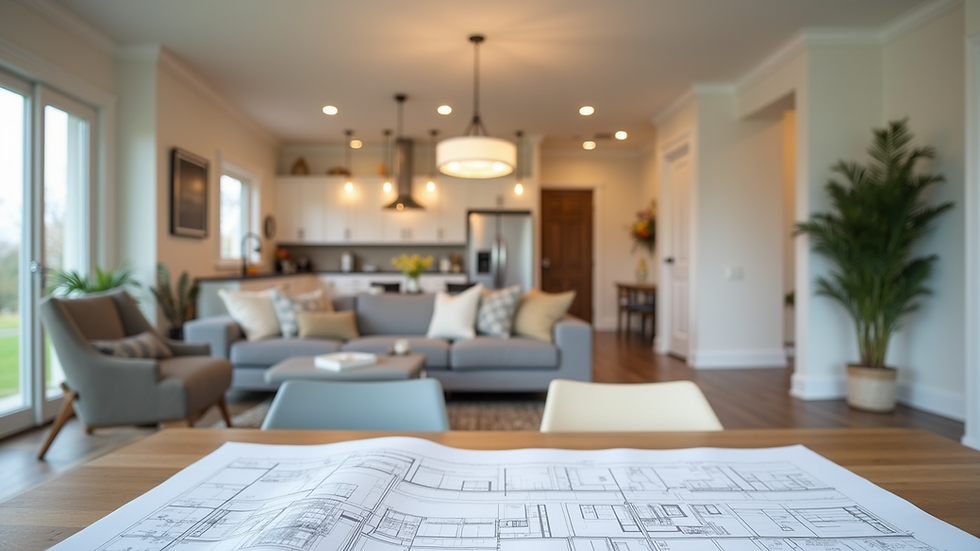Design Tips for New Homeowners
- christian mabry
- Sep 29
- 4 min read
Moving into a new home is such an exciting chapter, isn’t it? I still remember the thrill of stepping into my first place and imagining how I’d make it truly mine. But with all that excitement comes the challenge of turning a blank canvas into a space that feels like home. Whether you’re fresh off the closing table or planning your next big upgrade, having a clear design plan can make all the difference. Today, I want to share some practical, friendly advice that helped me—and can help you—create a home that’s not only beautiful but smartly designed for real life.
Design Tips for New Homeowners: Where to Start?
When I first started designing my home, I quickly realized that style alone isn’t enough. You need a plan that balances aesthetics with function. Here’s what I learned:
Start with a Vision Board: Gather images, colors, and textures that inspire you. This helps you clarify your style and keeps your design consistent.
Think About How You Live: Do you entertain often? Need a quiet workspace? Have kids or elders at home? Your design should support your daily routines.
Plan for Safety and Accessibility: Especially if you have seniors or veterans in the family, incorporating age-in-place features early on saves headaches later.
Create Source Lists: Knowing where to buy your furniture, fixtures, and decor saves time and ensures quality.
Use 3D Design Tools: These help you visualize your space before committing to purchases or renovations.
I found that having a clear plan made the whole process less overwhelming and more enjoyable. Plus, it gave me confidence when working with contractors and suppliers.

What is the 60/40 Rule in Interior Design?
One design principle that really changed how I approached decorating was the 60/40 rule. Have you heard of it? It’s a simple guideline that helps balance your space visually and functionally.
60% of your space should be neutral or base colors: Think walls, large furniture pieces, and flooring. These create a calm, cohesive backdrop.
40% should be accent colors and textures: This is where you add personality with pillows, rugs, artwork, and smaller furniture.
Why does this work? Because it prevents your space from feeling too busy or too bland. It also makes it easier to swap out accents when your tastes change without a full redesign.
For example, in my dining room, I kept the walls and table neutral but added vibrant chairs and a bold rug. It felt lively but not overwhelming.

Smart Design That Works for Life
Design isn’t just about looks—it’s about creating spaces that fit your lifestyle. Here are some tips I picked up that might help you:
Multi-Functional Spaces: Use furniture that can serve more than one purpose. A bench with storage or a fold-out desk can save space and add convenience.
Lighting Layers: Combine ambient, task, and accent lighting to make rooms adaptable for different activities.
Durable Materials: Especially if you have kids or pets, choose surfaces that are easy to clean and maintain.
Clear Traffic Flow: Arrange furniture so people can move easily without bumping into things.
Personal Touches: Incorporate items that tell your story—family photos, travel souvenirs, or handmade crafts.
When I applied these ideas, my home felt more welcoming and practical. It’s amazing how small changes can make a big difference in daily comfort.

How to Use Design Plans and Source Lists Effectively
One of the best decisions I made was to create detailed design plans and source lists before buying anything. This approach saved me money and stress. Here’s how you can do it:
Measure Everything: Accurate dimensions prevent costly mistakes.
Create Mood Boards: Collect images and samples to keep your vision clear.
List Every Item: From paint colors to light fixtures, write down what you need and where to get it.
Prioritize Purchases: Start with big-ticket or essential items, then add decor gradually.
Work with Professionals: Share your plans with contractors or designers to get their input and avoid surprises.
This method helped me stay organized and made my home upgrades feel manageable. Plus, it gave me a sense of control over the entire process.
Why HouseWork Designs is Your Go-To Partner
If you’re feeling overwhelmed by all the design choices, you’re not alone. That’s why I recommend checking out HouseWork Designs. They specialize in creating clear, contractor-ready plans that blend style, safety, and functionality. Whether you’re preparing your home for sale, upgrading for aging in place, or just want a fresh look, their expertise can guide you every step of the way.
Their approach is all about:
Style that connects emotionally
Safety and accessibility for all ages
Smart, organized plans that save time and money
I’ve seen firsthand how their designs transform homes into spaces that truly work for life. If you want to explore more, their blog is packed with helpful insights and inspiration.
Designing your new home is a journey, and with the right tips and tools, it can be a joyful one. Remember, it’s not just about making your space look good—it’s about making it work beautifully for you and your family. So take your time, plan smart, and enjoy every step of creating a home that feels just right.
Happy designing!



Comments